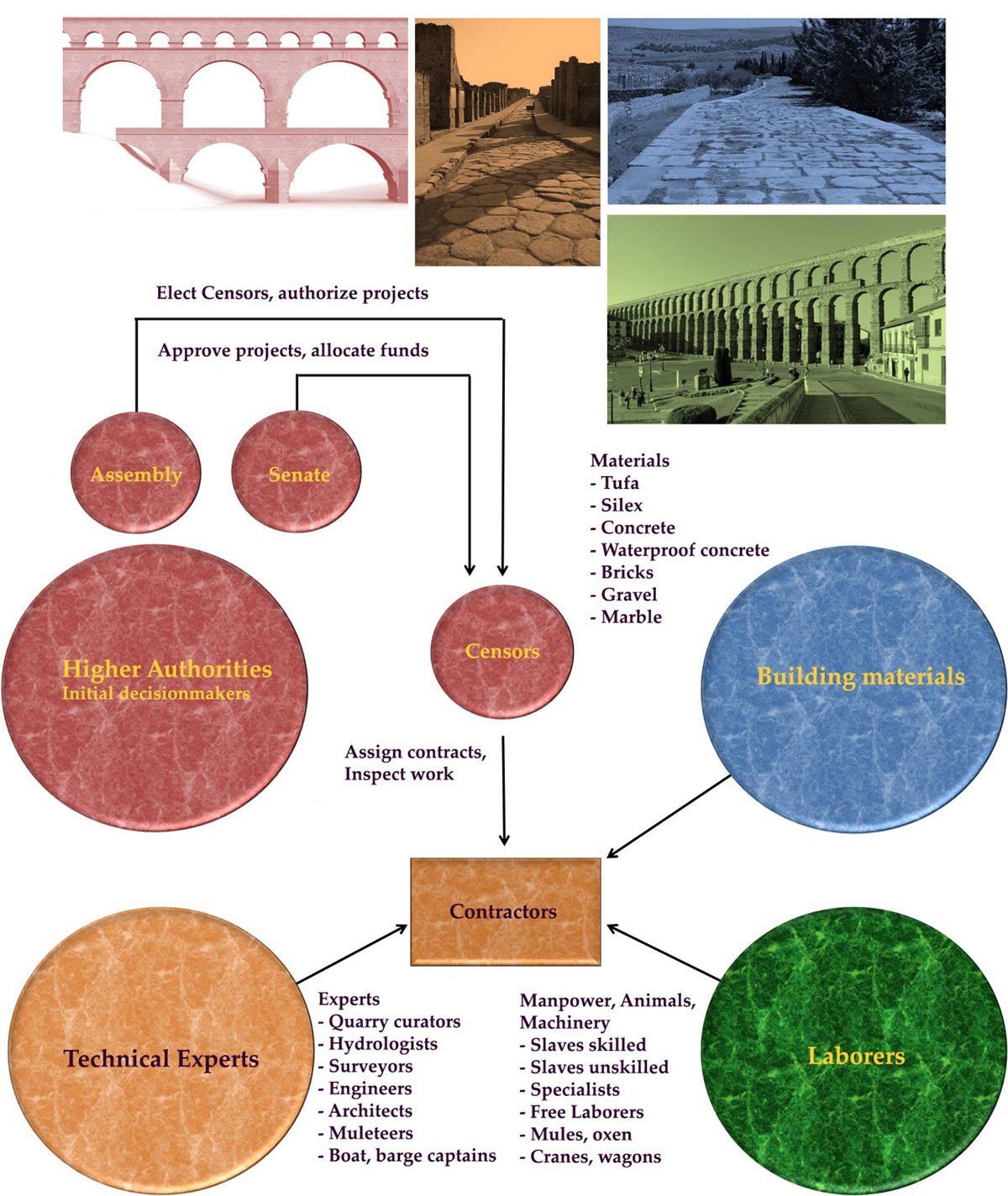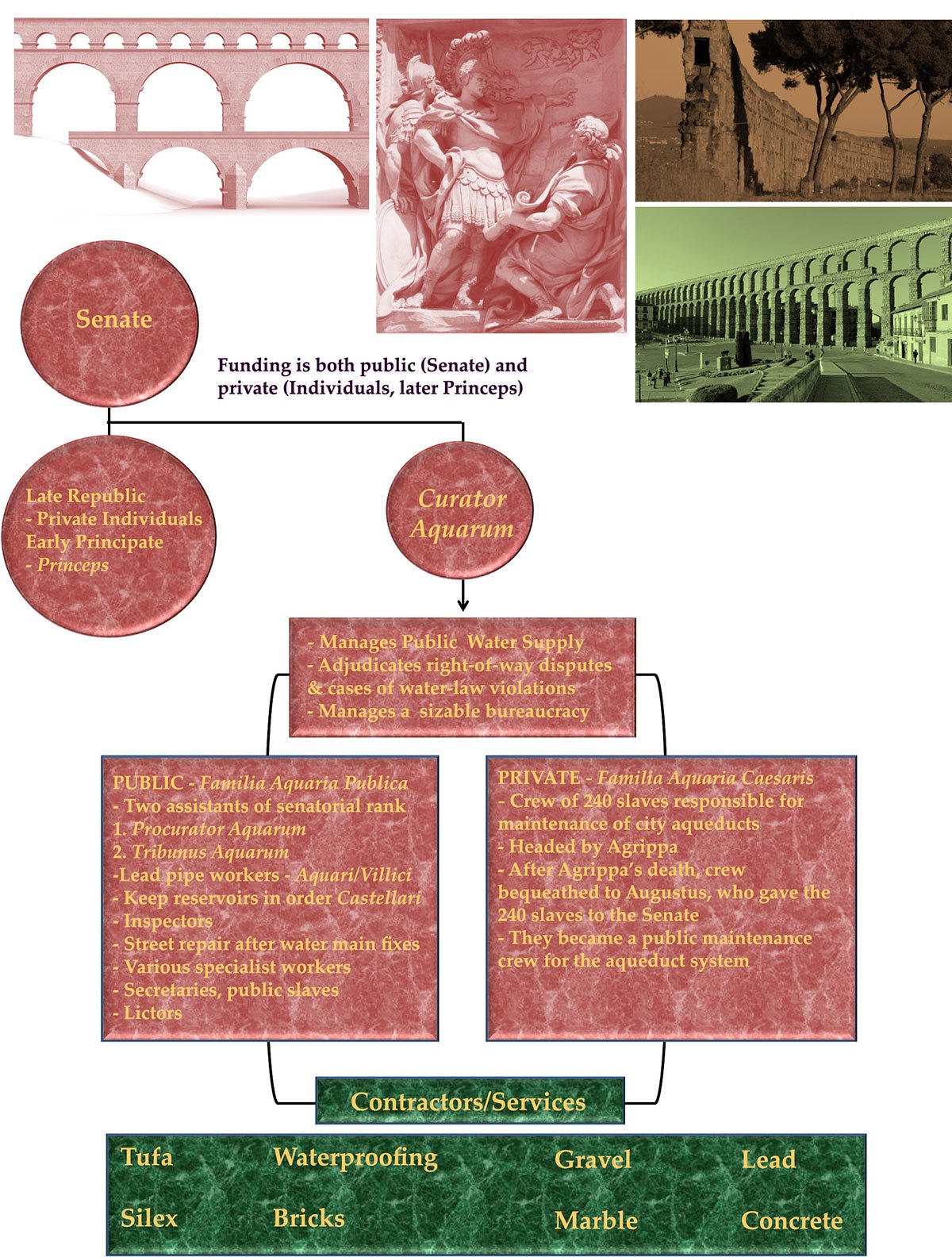Roman Building Projects
A Marker of Social Organization and Military Success
Republic
Aqueduct and Road building Projects under the Republic
- Political consensus (not an easy thing to achieve given the fractious nature of Roman senatorial politics)
- Substantial state funds (to pay for the large amounts of materials and labor)
- Mobilization of the technical expertise necessary to plan, build and maintain the projects in question
This diagram was developed by JS Konrad based on Dembskey EJ. The Aqueducts of Ancient Rome Master of Arts Ancient History University of South Africa February 2009, Page 17, citing O’Conner (1993):36. This diagram is the property of Pro Romanis, a GENCYA communications entity. It may be reproduced and used for educational purposes only. The graphic must be accompanied by the following language and link: “The diagram entitled Aqueduct and Road building Projects under the Republic Aqueducts is the property of Pro Romanis, a GENCYA communications entity, and may be used for educational purposes only. For more information please visit www.proromanis.com”.
Aqueducts
There were 11 major aqueducts built in ancient Rome between 312 BC and 266 AD. Five of them were built during the Republican period
- Aqua Appia
- Aqua Anio Vetus
- Aqua Marcia
- Aqua Tepula
- Aqua Julia
Aqua Appia
- The first aqueduct, built during the censorship of Gaius Platinus and Appius Claudius Caecus; Platinus located the water source and Appius was responsible for the construction
- It was 16.5 kilometers in length, traveled mostly underground, but rode on arches between the Caelian and Aventine hills
- It emptied into the Forum Boarium
Political and Military Implications
- Response to the inadequacy of the water supply in Rome
- Was an expression of the rising power of the common people versus the patricians
- Built despite resistance from the consuls at the time
- Initiated by Appius Claudius Caecus and the fact that the project went forward was a function of his power and prestige; he extended his tenure as Censor so that he could see the project through to completion
- Appius acquired even more clients as a result of allocating contracts for successfully undertaking such a large project
Aqua Anio Vetus
- Built between 272-269 BC with spoils from the Pyrrhic war
- It was anywhere between 64 and 81 kilometers in length, mostly underground
- The water was of low quality; used mostly for baths, industry and agriculture
- Building techniques were much more sophisticated than those used in making the Aqua Appia
Political and Military Implications
- Waters were used primarily for industrial and agricultural use, which reflects Roman commercial and agricultural expansion
- Infrastructure expansion followed military success
- Defeated the Samnites
- Outlasted Pyrrhus
- Reduced Bruttians and Lucanians in the South
- Conquered Magna Graecia
- Consolidating hold on Etruria and expanding into Gallia Cisalpina (both above and below the Po river)
Aqua Marcia
- Built between 144-140 BC with plunder from the destruction of Carthage and sack of Corinth
- Rome’s longest aqueduct, 91 kilometers long
- Built under the praetorship of Quintus Marcius Rex
- It was constructed to slake the thirst of a thirsty city that had doubled in size since the last aqueduct was built
- Brought the coolest and purest drinking water to Rome, especially to the higher elevations of Rome: the Palatine, Caelian, Aventine, Capitoline and Quirinal hills as well as lower elevations such as the Forum Romanum and the southern Campus Martius [Dembskey 2009, Page 111-114]
- Its water was hard, consequently it left large mineral deposits in the aqueduct channel that had to be frequently removed
Political and Military Implications
- Paid for with plunder from the destruction of Carthage and sack of Corinth
Aqua Tepula
- Built 127 BC during the censorship of G. Servilius Caepio and L. Cassius Longinus
- 18 kilometer long
- Delivered tepid water, mostly for industrial purposes
- 75% of its volume was designated for private use
- 15% of its volume designed for public use
- Agrippa rerouted its path
- Introduced to service the Capitoline hill; also the Templum Pacis, Esquiline hill, Alta Semita and Via Lata regions
- The Tepula built during the turbulent 120s BC; there was a slave revolt in Sicily led by Eunus
- May have been later (under Agrippa) converted as an ancillary distribution system for other aqueducts (Marcia and Julia)
Political and Military Implications
- Speaks to the increasing wealth of Rome; able to engage in projects that designated primarily for industrial purposes
- That parties that benefit directly are mostly the business class
Aqua Julia
- Built 33 BC during the aedileship of Marcus Agrippa; Octavian was ruling in Rome and the West, Antony ruled in Alexandria and the East
- 22-23 kilometers long
- The Julia supplied the Caelian, Isis and Serapis, Esquiliae, Alta Semita, Forum Romanum, Palatine, and Piscina Publica
- The primary terminus was the Viminal gate and a secondary branch delivered water to the Caelian and Aventine hills
Political and Military Implications
- Built 33 BC during the aedileship of Marcus Agrippa; symbolized the civic responsibility of Octavian, ruler of Rome and the Western Roman Empire
Political and military implications of aqueduct construction overall
- Reflect Roman control of the countryside around the city, otherwise the aqueducts could not be built
- Needed surplus income in order to build and maintain such a large and labor-intensive maintenance structure
- Required knowledge (specialists) to keep the aqueduct in working order
- Required a complex level of organization to build and maintain aqueducts
- The construction of the Aqua Appia followed or coincided with Roman success on the battlefield
- 327-326: Neapolis
- 326-304: The Samnites
- 312-298: The Marsi and other tribes of central Abruzzo
- 311-308: The Etruscans
- 310-308: The Umbrians
Aqueduct Project Organization under the Late Republic-Early Principate
Diagram developed by JS Konrad based on Dembskey EJ. The Aqueducts of Ancient Rome Master of Arts Ancient History University of South Africa February 2009, Page 17, citing O’Conner (1993):36. This diagram is the property of Pro Romanis, a GENCYA communications entity. It may be reproduced and used for educational purposes only. The graphic must be accompanied by the following language and link: “The diagram entitled Aqueduct Project Organization under the Late Republic-Early Principate is the property of Pro Romanis, a GENCYA communications entity, and may be used for educational purposes only. For more information please visit www.proromanis.com”.


